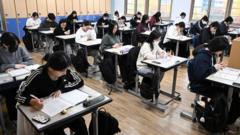As Japan and other Asian nations grapple with looming tariffs, the regional economic landscape is shifting. While some countries may gain negotiation time, others face mounting challenges, with the U.S.-Japan alliance particularly strained.**
Asia Faces Uncertainty as Trump’s Tariffs Shift Trade Dynamics**

Asia Faces Uncertainty as Trump’s Tariffs Shift Trade Dynamics**
President Trump's extended tariff deadlines cast doubt on the future of trade partnerships in Asia, leaving many nations reassessing their strategies.**
As President Trump continues to reshape international trade discourse with his tariff policies, Asia finds itself in a precarious position, trying to navigate unpredictable economic waters. Trump's recent threats to impose a 25% tariff on Japanese imports have left Tokyo, traditionally a steadfast American ally, scrambling for concessions to safeguard its car industry while resisting the pressure to open its markets to U.S. rice exports.
Japanese Prime Minister Shigeru Ishiba has formally criticized Trump's stance, expressing that the latest tariff discussions mark a concerning juncture in U.S.-Japan relations. Japan’s trade ministry has made several trips to Washington, D.C., since the tariff announcements earlier this year, but results have been minimal, further complicating Tokyo's efforts to avoid these punitive measures.
The U.S. government has intensified its approach, recently including Japan among a list of 23 nations—14 of which are in Asia—that are potential targets for tariff imposition. This week, Trump escalated tensions by announcing that Canada would be hit with a 35% levy, adding to growing anxieties among countries reliant on export-driven economies.
Experts point out that the extended deadline until August 1 offers countries like Thailand and Malaysia some reprieve, allowing them time to negotiate potential settlements before facing tariffs. The ongoing backdrop of U.S.-China trade tensions significantly impacts these negotiations, as Washington seeks to limit Chinese exports, even those routed through neighboring countries.
Nevertheless, while some nations may find an opportunity in the delay, the broader consequences of Trump's tariffs are stark. Economies heavily dependent on manufacturing, including sectors from textiles to technology, are set to bear the brunt. Analysts warn that while it is imprudent to label countries strictly as 'winners' or 'losers', the emergence of Vietnam and Cambodia as prominent exporters places them at grave risk if tariffs continue to grow.
Notably, the longstanding U.S.-Japan alliance is feeling the strain. Despite the strong economic ties, Japan finds itself treated on par with other Asian nations, according to economist Jesper Koll. Tokyo's resistance to U.S. demands—refusing to import American rice to protect domestic interests, for instance—illustrates its resolve to engage in negotiations on its own terms.
Looking ahead, the uncertainty created by Trump's tariff policies raises questions about the future of U.S. influence in Asia. With conflicting trade agendas between Washington and Beijing, observers suggest that this may signal a weakening of U.S. bargaining power. The expectation of future tariff adjustments leaves Asian nations with a complex challenge: adapting to the evolving trade environment while safeguarding their economic interests.
In this high-stakes game, both the U.S. and China appear to be recalibrating their approaches, with each vying to emerge as the more stable economic partner in a rapidly changing global landscape. As negotiations continue, the outcomes will likely shape not just the immediate economic realities for these nations, but their long-term diplomatic relations as well.



















